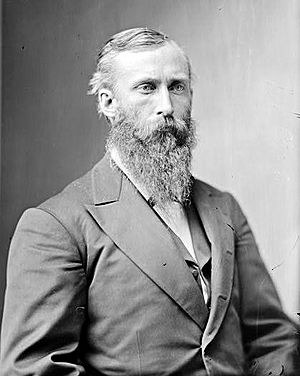Dudley C. Haskell facts for kids
Quick facts for kids
Dudley Chase Haskell
|
|
|---|---|
 |
|
| Member of the U.S. House of Representatives from Kansas's 2nd district |
|
| In office March 4, 1877 – December 16, 1883 |
|
| Preceded by | John R. Goodin |
| Succeeded by | Edward H. Funston |
| Member of the Kansas House of Representatives | |
| In office 1872 1875–1876 |
|
| Personal details | |
| Born | March 23, 1842 Springfield, Vermont, USA |
| Died | December 16, 1883 (aged 41) Washington, D.C., USA |
| Political party | Republican |
| Profession | Politician, Merchant |
| Military service | |
| Allegiance | |
| Branch/service | Union Army |
| Battles/wars | |
Dudley Chase Haskell (born March 23, 1842 – died December 16, 1883) was an important American politician. He was also a merchant and a veteran of the Civil War. Haskell was a member of the Republican Party from the Lawrence, Kansas area.
He first served in the Kansas House of Representatives. In 1876, he was chosen as the Speaker, which means he led the House. Later that year, he was elected to the United States Congress. He served there until he passed away in 1883.
As a congressman, Haskell led the Committee on Indian Affairs. This committee dealt with issues related to Native American tribes. He helped get approval to build three special schools for Native American children. One of these schools was built in Lawrence, Kansas. It opened in 1884 and was named after him in 1887. Today, this school is known as Haskell Indian Nations University.
Contents
Early Life and Education
Dudley Chase Haskell was born in Springfield, Vermont, in 1842. His parents were Franklin and Almira Haskell. In 1855, when he was 13, his family moved to Lawrence, Kansas.
He went back to Vermont for school in 1857 and 1858. After school, he started working as a shoe merchant. In 1859, he traveled west to join the Pike's Peak Gold Rush in Colorado. He lived there until 1861.
Service in the Civil War
When the Civil War began, Haskell returned to Missouri. He joined the Union Army. From 1861 to 1862, he worked as an assistant to the quartermaster. A quartermaster is an officer who makes sure soldiers have supplies like food, clothing, and equipment. Haskell helped with supplies in Missouri, Arkansas, Kansas, and the Indian Territory.
After the War and Political Career
After leaving the army, Haskell continued his education. In 1863, he attended Williston’s Seminary in Massachusetts. He then graduated from Yale College in 1865, when he was 23 years old.
He returned to Lawrence, Kansas, and worked in the shoe business from 1865 to 1867. Soon after, he became involved in politics with the Republican Party.
Serving in Kansas
Haskell was elected to the Kansas House of Representatives in 1872. He served again in 1875 and 1876. In 1876, his fellow representatives chose him to be the Speaker of the House. This was a very important leadership role.
Becoming a Congressman
In 1876, Haskell was elected to the United States House of Representatives. He represented Kansas's 2nd congressional district. He served in Congress from 1877 until his death in Washington, D.C. on December 16, 1883.
While in Congress, he became the chairman of the Committee on Indian Affairs. He led this committee from 1881 to 1883. Haskell strongly believed in education for Native American children. He supported laws to build three special boarding schools for them. These schools would be located in Nebraska, Kansas, and the Indian Territory.
He successfully worked to have the Kansas school built in his hometown of Lawrence. This school opened with only 22 students. It grew quickly and was named Haskell Institute in his honor four years after he passed away.
Dudley Chase Haskell was buried in Oak Hill Cemetery in Lawrence, Kansas. He was married and had a family. His grandson, Otis Halbert Holmes, also became a politician. Holmes served as a US Representative from Washington state.
Legacy and Honors
Dudley Chase Haskell is remembered for his work, especially for Native American education.
- The school he helped establish in Lawrence was named the Haskell Institute in 1887. Today, it is known as the Haskell Indian Nations University. It is a very important school for Native American students.
- A place in southwestern Kansas, Haskell County, is also named after him.
See also
- Haskell Indian Nations University
- List of United States Congress members who died in office (1790–1899)

